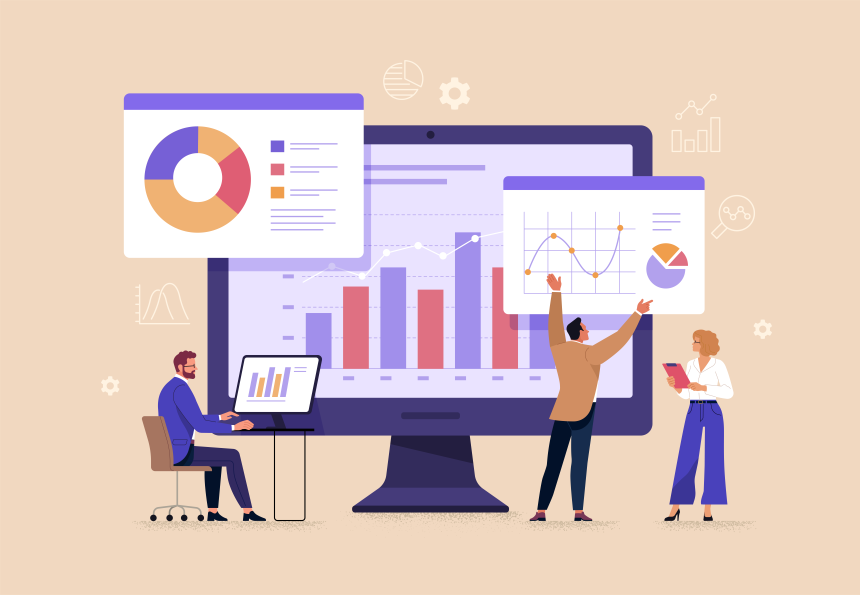How to Make the Most of Customer Service Analytics
by Erina Suzuki | Published On November 6, 2023 | Last Updated November 14, 2025

Customer service analytics help contact centers understand what’s happening now and what’s coming next. Learn how insights from segmentation, predictive, and real-time analytics improve customer experience, agent performance, and overall service efficiency.
In today’s customer-centric and data-driven world, relying on intuition alone no longer cuts it. Customer service analytics have become the backbone of call center strategy, turning every interaction into actionable insight. Modern contact centers have evolved from cost centers into strategic assets and stand as rich reservoirs of invaluable customer data, capturing every nuance of client interactions.
By leveraging call center analytics tools, companies can analyze customer-agent interactions to improve service quality and performance. This not only offers a window into customer sentiments and pain points but also lays out a roadmap, revealing clear avenues for refining processes and driving optimization.
With the right insights and actions, companies are primed to experience significant returns, with projections suggesting gains of more than 20% in total company revenue. This blog explains how customer service analytics, from segmentation to predictive models, turn raw interaction data into meaningful insights that strengthen customer experience, improve agent performance, and guide smarter decisions.
What is Customer Service Analytics?
Customer service analytics refers to the process of collecting, analyzing, and interpreting customer interaction data to improve service quality, operational efficiency, and overall customer experience. Modern call centers handle multiple channels that track and analyze volumes of data on the customer journey. This includes quantitative metrics like average handle time, response rate, resolution speed, and other key performance indicators, as well as qualitative insights such as sentiment, emotion, and intent. Together, these form the foundation of call center data analytics.
Customer service analytics tools not only capture this data but interpret it in ways that are actionable. More advanced analytics platforms go beyond surface-level reporting. AI-driven tools like Creovai can integrate with contact centers to analyze interactions by leveraging natural language processing (NLP) and speech analytics to identify patterns in conversations, highlight customer sentiment and surface actionable insights in real time. This data gives full visibility into the customer journey from the first word spoken to when the call ends.
Utilizing Analytics to Enhance Customer Experience

Segmentation Analytics: Understanding What’s Happening Now and Why
In the world of contact centers, analytics directly impact customer satisfaction scores. Research shows that 72% of businesses express confidence that call center data analytics reports have the capability to improve customer experience. One of the cornerstone metrics in this domain has always been First Call Resolution (FCR). However, as these centers expand across multiple channels, simply noting FCR isn't enough. Delving deeper into the underlying reasons for repeated customer contact becomes paramount.
Segmentation analytics emerges as a robust tool in this scenario, meticulously categorizing customer interactions by:
- Issue type or product lines
- Communication channel used (voice, chat, email, etc.)
- Classification of customer sentiment or emotion (i.e. how did the customer sound?, etc.)
- Agent performance metrics
Whether they’re product glitches or service deficiencies, once pinpointed, these challenges can be tackled head-on, minimizing repeat contacts and significantly enhancing overall customer satisfaction.
Predictive Analytics: Understanding What Will Happen Next and How To Address It
The pressure for businesses to understand their customers has never been higher. Around three-quarters of customers anticipate that businesses will have a deep understanding of their needs and expectations. This statistic underscores the crucial role of predictive analytics. By analyzing historical data, call trends, and real time insights harmoniously, potential customer issues can be identified before they escalate.
For instance, predictive analytics can:
- Forecast spikes in call volume, allowing managers to optimize staffing levels.
- Analyze sentiment over time to signal emerging dissatisfaction in specific customer segments.
- Detect recurring issue patterns to help product teams fix underlying defects proactively.
- Identify high-risk accounts to tailor specific customer experience strategy.
- Predict churn with significant accuracy, allowing call centers to engage in pre-emptive measures.
With these capabilities, predictive analytics shifts customer service from a reactive function to a proactive engine for improvement. It empowers teams to stay ahead of customer expectations, reduce friction, and create a more consistent and reliable service experience.
Analyzing Agent Performance Metrics

Contact centers that leverage analytics, especially with tools that employ NLP, provide a rich outlook on agent performance by gauging sentiment, tone, and emotion from call transcripts.
According to a 2021 study, a staggering 74% of disengaged workers expressed a willingness to leave their current roles for another opportunity. There's an undeniable link between low engagement and reduced productivity. By leveraging NLP analytics, supervisors can receive and provide detailed feedback to their agents.
These advanced tools analyze elements such as:
- Tone and sentiment: Detecting frustration, satisfaction or confusion in a customer’s voice.
- Keyword trends: Identifying recurring terms linked to pain points or positive feedback.
- Agent empathy and language use: Measuring how agents communicate, reassure, and resolve issues.
- Emotional trajectory: Tracking how a conversation’s tone changes from start to finish to gauge de-escalation skills.
When agents are empowered with a clearer understanding of their strengths, areas for improvement, and the broader impact of their interactions, they're more likely to feel valued and engaged in their roles. In turn, this can help retain talent and ensure that call center agents are not just efficient but also empathetic and solution-driven. This helps improve the customer experience overall.
Turning Data into Action
Embracing customer service analytics is not an option but a necessity for contemporary contact centers. It shifts the narrative from reactive problem-solving to proactive strategy formulation. With a sound analytics strategy, contact centers can optimize operations, enhance agent performance, and, above all, deliver a customer experience that fosters loyalty and growth. As we chart the future of customer interactions, it's clear that the centers equipped with robust analytics will lead the way, turning every challenge into an opportunity for excellence.
Want to see how customer service analytics are used with ice Contact Center? Request a demo with one of our reps and see the true value of real-time contact center insights!
More from our blog
 Oftentimes, we hear organizations emphasizing the importance of customer experience. While the customer experience plays a dominant role for organizations, the employee experience usually gets overlooked.
Oftentimes, we hear organizations emphasizing the importance of customer experience. While the customer experience plays a dominant role for organizations, the employee experience usually gets overlooked.
 Explore how Microsoft Teams Phone Extensibility transforms contact centers and learn how ComputerTalk delivers seamless, AI-ready integrations.
Explore how Microsoft Teams Phone Extensibility transforms contact centers and learn how ComputerTalk delivers seamless, AI-ready integrations.
 On Wednesday, February 7, ComputerTalk hosted our latest Slice of ice webinar. During this session, one of our training and documentation specialists, Diane Vasquez provided an overview of iceReporting and discussed key iceReports, how to schedule reports, what’s new in...
On Wednesday, February 7, ComputerTalk hosted our latest Slice of ice webinar. During this session, one of our training and documentation specialists, Diane Vasquez provided an overview of iceReporting and discussed key iceReports, how to schedule reports, what’s new in...

